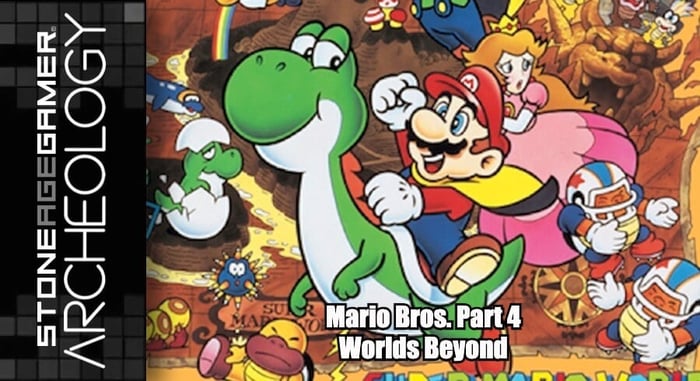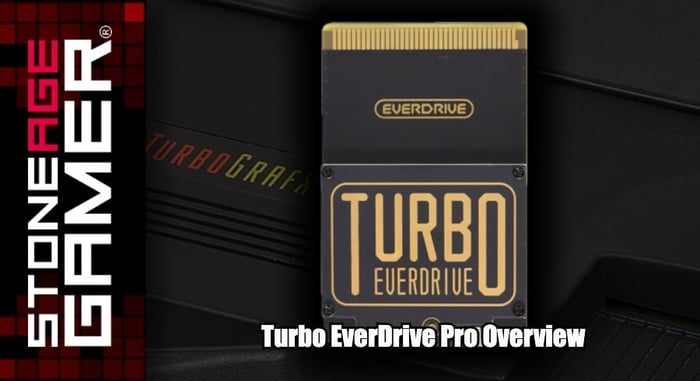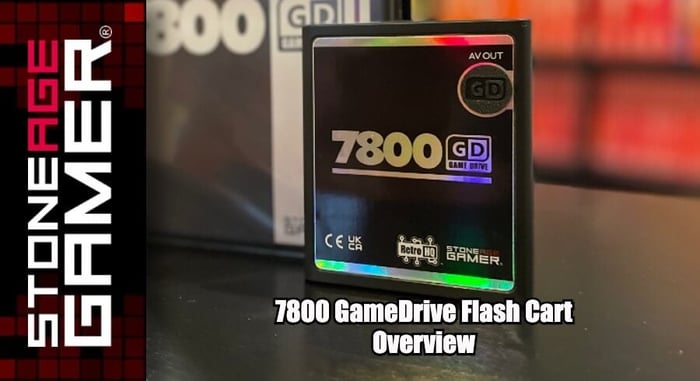
Mario Bros. Retrospective Part 4 - Worlds Beyond
Welcome to Part 4 of our Mario Bros. retrospective! In this episode, we take a look at Mario's first 16-bit adventure, dive into his history with pinball, bid farewell to the Nelsonic Game Watch, and celebrate one of the finest Game Boy games ever made.
In this series, we aim to tell the story of the Mario Bros. series as it unfolded for North American audiences. We are not only looking at the games themselves, but the historical context surrounding them, and what it was like being a fan as these games were being released.
Note: The Super Mario Bros. Pinball machine shown in this video has been modified. More details about the machine can be found here: https://levelupentertainment.com/blog/2018/8/9/super-mario-bros-pinball
These are some of the invaluable sources that this project wouldn't have been possible without:
Video Works: https://youtu.be/cdUDvoGFp8s?si=8tZLecvzwVAtWLIJ
The Super Mario Wiki: https://www.mariowiki.com/
The Gaming Historian: https://thegaminghistorian.com/
Leonard Herman: http://www.rolentapress.com/
Supper Mario Broth: https://www.suppermariobroth.com/
Watch more Stone Age Gamer Archeology: https://www.youtube.com/playlist?list=PLoWJAVdwC7Z_CCqXEIJTcDQhVoxTcmPU7
SupaBoy Portable Super NES Console - Hyperkin

$0.00
The handheld Hyperkin SupaBoy will play original SNES (NTSC AND PAL) and SFC cartridges on a built-in 4.3 inch LCD screen. It includes a D-pad...… read more
Transcript of the video:
With the unprecedented success of Super Mario Bros. 3 finally released worldwide, fans once again found themselves wondering what would be next. The Nintendo Entertainment System was about as successful as anyone could have hoped, but technology stands still for no one, and the NES was beginning to show its age. Nintendo’s existing hardware still had some life left in it for sure, but it was time to start planning for the future. It was time for Nintendo to create their first “next generation” platform.
In the January 1991 issue of Nintendo Power, Nintendo gave fans their first glimpse of their upcoming 16-bit machine, the Super Nintendo Entertainment System. And there was no better way to show off what this impressive new hardware would be capable of than with the reveal of Super Mario Bros. 4: Super Mario World.
While early looks at F-Zero and Pilotwings shared the page, the primary focus was on Mario’s new adventure. The four screenshots were tiny, but they showcased colorful, detailed graphics that the NES could never hope to accomplish. If this new game could deliver the same way Super Mario Bros. 3 did, Nintendo would surely maintain their dominance in the home video game console market. Little did they know, one of their oldest competitors was about to change the game.
When Nintendo entered the home video game market in North America, they did so almost completely unchallenged. Competitors for the NES existed, but the likes of the Atari 7800, Sega Master System, and Turbo Grafx-16 were never able to make much of a dent in Nintendo’s commanding market share, at least not in any meaningful fashion. Of those competitors though, one wouldn’t be dissuaded so easily.
Sega had a rich history in the video game market dating all the way back to the early arcade days when Nintendo struck it big with Donkey Kong. But while they managed a reasonable degree of success in Japan, it always paled in comparison to Nintendo’s. Their latest hardware, the 16-bit Genesis console, wasn’t faring much better. Even with its far superior graphics and sound, the Nintendo brand was just too well established, and its stable of recognizable characters ensured that if kids wanted to play video games, Nintendo was the place to do it.
Sega’s strategy wasn’t working, so instead, they decided to try and beat Nintendo at its own game. If Nintendo’s appeal was for families and children with their colorful mascot Mario, Sega would create a mascot of their own.
Sonic the Hedgehog was released for the Sega Genesis on June 23 1991, exactly two months before the US launch of the Super NES. The game was an immediate success thanks to its colorful visuals, excellently crafted gameplay, and Sonic’s extremely marketable design. While Mario had always been a bright, cheerful personality, Sonic was poised to be more like the popular animated character Bart Simpson, complete with his signature “attitude” that appealed to a slightly older audience than their competition. Nintendo was still popular, but Sega was “cool” and Genesis sales skyrocketed. In a very short period of time, the video game landscape had changed. Nintendo was now faced with an uphill battle against some incredibly fierce competition. Still, the hype for the Super NES had grown significantly, with various gaming magazines posting images and previews from the Japanese Super Famicom for months. The pressure was on for Super Mario World to deliver.
Thankfully, it did.
Super Mario World launched on August 23 1991 as a pack-in title for the Super Nintendo Entertainment System, dropping the super Mario Bros. 4 moniker in the region, and while it lacked much of the flash its new competitor had shown off so well, it made up for it in charm and substance, best described by Nintendo themselves.
-commercial
Super Mario World built on the foundation of Super Mario Bros. 3, and refined it to an almost unbelievable shine. Super Mushrooms and fire flowers returned, as did the ability to fly thanks to the new Cape Feather. Unlike the racoon tail though, once Mario’s initial flight power ran out, he could grab the cape’s corners and use it almost like a sort of hang glider to stay in the air indefinitely, once you mastered the tricky controls, that is.
Speaking of controls, they were tighter than ever, with Mario and Luigi exhibiting more speed and agility than before. They also had some new moves at their disposal, like the ability to look around by moving the camera, and a powerful new spin jump that allowed them to bounce off of spiked objects, instantly destroy Koopa shells, and more.
There were new powerups as well like the Power Balloon and the 3-Up Moon, but perhaps the most significant of them all came not in the form of a new collectible, but a new character, Yoshi.
Series creator Shigeru Miyamoto had envisioned Mario riding a dinosaur as far back as the original Super Mario Bros., but the NES hardware was never able to pull it off properly. The Super NES though, had power to spare, making the realization of Mario’s new reptilian steed a snap. Yoshi was an adorable dinosaur with a bottomless appetite for enemies. The vast majority of creatures Mario encountered could be swallowed whole, with the notable exception of Koopa Troopas, whose shells took Yoshi a much longer time to swallow. This, though, was actually tied to a new mechanic exclusive to players riding Yoshi. Depending on the color of the Koopa shell, Yoshi would earn special abilities. Red shells allowed Yoshi to exhale a trio of deadly fireballs. Yellow shells would allow Yoshi to create powerful earthquakes whenever he landed, and the much sought after Blue shells made Yoshi sprout wings granting him the ability to fly.
Super Mario World was still an action platformer like its predecessors, but a sizable portion of the gameplay was now devoted to expanding on the sense of exploration that Super Mario Bros. 3 established. The world map was filled with alternate paths, colorful landmarks, and could change dramatically when stages were completed. The stages themselves also contained multiple exits, branching paths, and more. On the world map, stages that were represented by a red dot indicated that they contained more than one exit, while yellow dots only contained one. These alternate exits could be completely different stage endings, or keyholes which Mario or Luigi would need to find the keys for hidden somewhere in the levels. Hidden exits ranged from fairly straightforward to remarkably devious, once again making the game a frequent topic of conversation among players as they strived to find everything this new adventure had to offer, a feat that would be rewarded by a star icon on a player’s save file.
As for the story, Super Mario World takes place shortly after the events of Super Mario Bros. 3.
Mario, Luigi, and Princess Toadstool decided that they were in need of a vacation, and took a trip to the nearby Dinosaur Land. While Mario was napping on the beach, the Princess disappeared. He and his brother went searching for her and came across an enormous egg in the forest. As they approached it, Yoshi popped out and told the Mario Bros about how some monstrous turtles had captured his friends and sealed them in similar eggs. Yes, Bowser had indeed returned, and not only kidnapped Princess Toadstool, but Yoshi’s friends as well.
And so began the Mario Bros.’ first 16-bit adventure. They traveled from Yoshi’s Island, across the Donut Plains, through the Vanilla Dome, the Forest of Illusion, the Chocolate Islands, and more, once again defeating the Koopa Kids, each of which guarded another one of Yoshi’s imprisoned friends. Along the way, players got to experience Mario’s world in a more alive fashion than ever before. Koopa Troopas flew out of their shells when stomped on. Thwomps gave Mario suspicious looks before slamming down at them. Everything was brighter and more beautiful than the series had ever been, and there were secrets and surprises around every corner.
The adventure eventually led players to a sunken airship from Super Mario Bros. 3, and once they grabbed the familiar question mark token from inside, the pathway opened up to the Valley of Bowser, where the fiend’s new castle awaited for an extremely memorable final showdown.
Bowser attacked in the Koopa Clown car, which made its series debut here, in a multi-phase battle that was far more complex than any previous Bowser encounter. But as always, Mario was able to defeat him, free the Princess and the other Yoshis, and enjoy the rest of his vacation in peace.
Super Mario World was a very successful game, due in no small part to the fact that it was included with the Super NES console, but for as great as it was, it failed to achieve the same impact as its predecessor. It wasn’t immediately obvious to players just how much more complex it was than Super Mario Bros. 3, and then there was the Sonic factor. Sega’s new mascot’s meteoric rise in popularity doubtlessly delivered a hefty blow to Mario’s appeal, while simultaneously igniting one of the most entertaining rivalries in the history of gaming.
But while it may not have enjoyed the immediate levels of success as Mario 3, Super Mario World was still enormously popular, especially its new character Yoshi. The Mario cartoon once again changed directions to be based on Super Mario World, the brand saw merchandising on everything from T-shirts to Macaroni and Cheese. A new Super Mario World comic ran for 12 issues as part of Nintendo Power, and of course, longtime partners Nelsonic were back to try one more time to fit Mario’s latest adventure onto the smallest screens available.
Super Mario Bros. 4: Super Mario World was released in 1991, and much like its predecessors, looked like a perfectly legitimate Mario product on the surface, but actually takes place within its own unique continuity. It’s also the only game released in North America to retain the Super Mario bros. 4 name, which was removed from the final super NES release.
Following the events of the Super Mario bros. 3 Game Watch, Super Mario Bros. 4 sees the return of the Koopa Dragon, or Koopa’s Dragon as he’s now referred to, who has once again kidnapped the princess and taken her to Dinosaur Island. The playfield is even more complex than before, as the game tried to incorporate Yoshi into the mix, even though the name Yoshi is never used. Just like the other Nelsonic releases, everything in the game went by strange, off brand names. Yoshi was just Dinosaur, Koopa Paratroopas were flying tortoises, Dolphins were Globfish, and Magikoopa was labeled as Witch, possibly alluding to the witch from the first game that was never shown, and was mysteriously absent from its sequel.
But most unusual of all was the interpretation of the Cape powerup. Instead of grabbing a feather, the powerup was called the Super Fur, which in lieu of granting Mario a magic cape, was said to give him a poncho.
Players had to collect a special coin, mount the Dinosaur, cross a bridge, traverse moving platforms, get the Poncho, and use it to defeat the Koopa’s Dragon. It was no easy task, and the objectives were near impossible to figure out without the included instruction manual, but as always some degree of fun was there for any players willing to put the effort into finding it.
Super Mario Bros 4 was arguably the most playable of the three Nelsonic Watch games, but it was still a far cry from what players had come to expect from a Mario game, even a portable one. Fun new features were included like a headphone jack which allowed players hear the game’s abrasive beep sounds in slightly higher quality if they wanted, but it never caught on as much more than a novelty, and would be Nelsonic's final Mario release. Fans wanted more out of a portable Mario adventure, and it wouldn’t be long before more is exactly what they got, but first, arcade goers would get a chance to interact with Mario’s world like never before, and experience some surprising series firsts in the process.
In the early 90s, Arcades were going through a metamorphosis in North America. In 1991, Capcom introduced Street Fighter II, which ignited the fighting game craze, welcoming crowds back into arcades in numbers not seen in years. But while different gaming fads came and went in the arcade scene, one thing remained constant, pinball. And while pinball tables based on video game properties were hardly anything new, none of them were ever based on Nintendo games before. That all changed thanks to pinball manufacturer gottleib.
Super Mario Bros. was released in arcades in April 1992, introducing the world of Mario to pinball enthusiasts all over the country. It was a standard sized table complete with the usual modern pinball trappings like chutes, bumpers, and more. It featured a Dot Matrix display, a first for a Gottleib pinball machine, that showed off various graphics, bonuses, and even a brief unlockable platforming segment where players would make Mario jump with the right flipper.
The object of the game was to rescue the Princess by destroying seven castles which could only be done once players became Super Mario by hitting specific targets to light up the letters that spell the word SUPER in the middle of the table, all while avoiding various traps, earning points and bonuses like multiball and the aforementioned Video Mode, and more.
It was a very creative game, earning itself a Gold Award from the American Amusement Machine Association, and performed well thanks to the popularity of the Super Mario brand. It also marked one of, if not the only time official artwork featuring characters from all of Mario’s previous console adventures appeared in a single licensed property together, including Super Mario Bros. 2. Wart had seemingly captured Luigi in a castle that was being guarded by Clawgrip. World 3 featured Super Mario World’s Reznor next to Fryguy. And while the Bowser on the table itself was the same one seen in the Super Mario World instruction manual, his design from the cartoon series could be seen on the backglass. But something far more momentous came from the sound department, as this game marks the first official product where Mario was voiced by Charles Martinet, who in the future would famously take on the role in a more permanent fashion.
Just two months later in June 1992, Gottleib also released a second Mario themed pinball table called Super Mario Bros.: Mushroom World. This game was unique in that it was considerably smaller than most standard tables, and also featured collapsable legs for relative ease of portability and offering a lower height for children to use. Unlike its predecessor, this was also designed to be a redemption machine, capable of dispensing tickets. As for the game itself, it’s largely based on Super Mario Bros. 3 with the majority of its artwork coming directly from that game’s promotional material , with the curious exception of Toad, who appears on the table itself as he was drawn in the various Super Mario bros. Cartoons.
This Time around, players would have to make their way through eight worlds, defeating the Koopalings and Bowser in each by hitting various targets. It’s a much more simplistic game than Super Mario Bros. partially due to its significantly smaller size, but it still managed to contain several secrets, slides, ramps, and its own Video Mode. Unfortunately, this table’s reception wasn’t nearly as good, with many citing it as not being very much fun to play.
Both of these pinball machines have become very collectible, with the first game being rather difficult to find in working order as it’s highly susceptible to falling into disrepair, and Mushroom World being genuinely scarce thanks to its production run only consisting of 519 total units. Still, they were an interesting experiment, and a fascinating piece of Mario’s history.
Back in the realm of video games though, Nintendo was already gearing up for Mario’s next platforming adventure. In the July 1992 issue of Nintendo Power, they gave readers an early look at Super Mario Land 2. Two screenshots were all that was shown, but they could only be described as a massive improvement over Super Mario Land’s simplistic visuals. The intent seemed to be to create something more in line with Super Mario World on the Game Boy, and with an idea like that, hype began to build. Just a few months later, fans wouldn’t merely get to experience a whole new journey to yet another bizarre Mario land, but they’d also get to meet his brand new nemesis.
Super Mario Land 2: 6 Golden coins was released on November 2, 1992, and expanded on Super Mario Land exponentially. Once again handled by Nintendo R&D1, Super Mario Land 2 felt very different from its home console brethren, but was still distinctly Mario in all the ways that mattered. Its overall visual style was designed to mimic what was established in Super Mario World, particularly Mario’s sprite, but every other aspect of the game featured completely unique elements, with even familiar enemies taking on whole new looks. Thanks to the Game Boy’s black & white screen, 1-up mushrooms were once again replaced by hearts, but gone were the Superballs, with the classic fireballs returning to take their place. The main new powerup on order was Bunny Mario. By grabbing the carrot item, Mario would sprout Bunny ears that would allow him to float by tapping the A button, similar to the raccoon tail in Super Mario Bros. 3, only without the power of flight.
While away fighting Tatanga in Sarasa Land, a childhood nemesis of Mario’s named Wario took over his castle and enslaved the people of Mario Land. He stole the 6 Golden Coins and gave them to his guards to keep them away from his apparent longtime rival. This story didn’t make much in the way of sense, as up to this point Mario Land was never referred to as an actual place, nor was it ever stated before that Mario had his own castle. But the appeal of Wario as a villain was immediately apparent, a fact that Nintendo was keenly aware of, featuring him prominently in the game’s memorable ad campaign.
Living up to its promise, Super Mario Land 2 was one of the biggest Game Boy adventures Nintendo had created up to that point. While still nowhere near as large as Super Mario world, the game featured its own set of branching paths, secret exits, and a highly detailed map, particularly by game Boy standards. Each zone was wildly different, from the haunted Pumpkin Zone, to the enormous Macro Zone, to the immensely weird Mario Zone which takes place inside a giant mechanical Mario statue. They all featured their own unique boss characters, including a return appearance from Tatanga in the Space Zone, and once defeated, Mario would gain one of the 6 Golden Coins required to get back into his castle for a final confrontation with Wario himself. This was different from any previous Mario boss, because unlike Bowser, Wario was human. The three phase battle required Mario to overcome Super Wario, Bunny Wario, and Fire Wario. Once defeated, the villain returned to his smaller size, but ran away before Mario’s castle returned to normal.
Super Mario Land 2: 6 Golden Coins was a tremendous achievement on the Game Boy, pushing the hardware to its limits. It went on to sell over 11 million units, and is often considered one of the best Game Boy games ever made.
As is always the case, fans quickly became eager to learn what would be next for their favorite plumber, but there wouldn't be a new proper Super Mario adventure for another four years, one that would once again change the industry forever. As history has shown though, Mario himself is only one piece of a very complicated tapestry. So while Nintendo began working on their next revolution, Mario and his extended family would set out on some new adventures of their own.
Join us next time as we take a look at the various spinoff series connected to Mario’s universe, and what is often regarded as one of the best video game remakes ever made.





